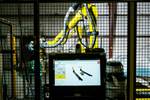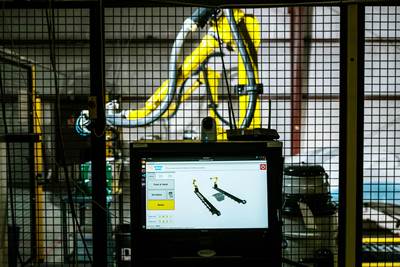Cobot Enters Paint Industry With Safety at the Forefront
This collaborative robot is the first explosion-proof solution for the powder coating and paint arena that meets the U.S.’ stringent safety requirements. Its lead-through teach programming and tablet control are especially appealing to small shops with little proficiency in robotics.
Robots are often integrated on a shop floor to complete jobs that might be dangerous for an operator. However, some environments are not completely suitable for robots for safety reasons. For instance, until recently, there was not a collaborative paint robot available that was explosion-proof, making powder coating and painting in a spray booth with a collaborative robot (cobot) potentially dangerous.
But with the development of the explosion-proof CRX-10iA/L Paint cobot from FANUC (Rochester Hills, Michigan), safety and environmental standards for powder coating and paint booths in the U.S., Europe and Asia have been met. This cobot also includes a critical and unique enhancement for a cobot environment: a force sensor in each joint, which enables lead-through teaching and hands-on programming.
“We wanted to launch the success that we’ve had with our conventional CRX robot in the non-paint world and launch that product line in the paint world by creating a collaborative version,” says Barton Faylor, program manager at FANUC. To do this, company engineers purged and pressurized the manufacturer’s existing cobot to meet the requirements of the paint industry. “I won’t say it was a simple task, but it was a definable task that gave us a robot in the collaborative world,” he adds.
Besides the typical automation advantages that cobots offer in general, users of the new CRX model are impressed with its ease of use, according to Faylor. The tablet control and the ability to simply grab the robot and move it through the motions to program it are some of the technology’s popular characteristics.
Flexible, safe automation
Although the CRX paint cobot is designed for both powder coating and liquid paint applications, FANUC is learning from users that powder coating is ideal for the technology because powder is more forgiving than paint, Faylor says. “If you leave the gun turned on for too long, that doesn’t hurt you in the powder world.”

The six-axis FANUC CRX-10iA/L Paint collaborative robot (cobot) is designed for easy programming and use, is maintenance-free for eight years and is compatible with other equipment used in paint and powder coating processes. Source (All Images) | FANUC America
Robotic powder coating provides precision, efficiency and consistency. Add the advantages of cobot characteristics, and users are gifted with the ease of programming, a small footprint and the ability to work safely.
Even though cobots are safe by design, FANUC understood that another layer of safety was a must when the company developed its paint cobots. With stringent safety requirements in the U.S. for equipment inside of a paint booth, which can be a hazardous environment, the CRX was created with explosion-proof qualities.
“When paint/powder chemicals are combined with the use of a robot without safety precautions, the situation is unsafe,” Faylor says. “The volatile organic compounds of solvent-borne paint or powder coating dust, when atomized, can cause an explosion or fire.”
The explosion-proof paint cobot, the first of its kind, is lightweight (45 kilograms) with a long reach of 1,418 millimeters and a 10-kilogram payload. Although the cobot can coat large parts, it is most practical in applications where parts are the size of a 3-foot cube, or in other words medium-size parts, Faylor says.
As far as volume size is concerned, he suggests a number that’s not too high nor too low. “If it takes any more than a couple of hours to set up the robot and get it painting, then that’s too much for short runs, but for a longer run, it makes more sense to make that investment,” he explains.
Easy installation
Robots can be intimidating for small shops that lack experience with automation. The CRX paint cobot’s design, however, presents an unthreatening option for these coating environments. Setup can be as easy as rolling a cart to a booth today and moving it out of the way tomorrow, Faylor says. And even if a shop opts for a permanent location for the cobot, because the robot arm is lightweight, it’s not difficult to install.
A simple connection from the cobot to the powder hopper will turn the powder on and off. The voltage and flow are set at the hopper, incorporating the same controls as manual sprayers that operators already are familiar with.
Whether the user chooses to install the robot application independently or prefers an integrator to take the lead, FANUC supports both alternatives. While the robot OEM supplies packages and documentation for the DIY customer, it also collaborates with dedicated system integrators that administer robot services as well as fluid delivery system components. Depending upon the system peripherals, a one- to two-day installation can be expected, according to Faylor.

The CRX paint cobot offers a small footprint, repeatability of ±0.04 millimeter, a 10-kilogram payload and 1,418-millimeter reach.
Programming made simple
While traditional robots have many advantages, they often must be operated by a programmer. However, many shops do not have the resources to invest in one. This is where cobots are especially useful because anyone — even those with no programming skills — can program the CRX-10iA/L Paint cobot.
“If they’ve never programmed this before, we can get somebody to teach our robot in five minutes or less, knowing paint and the right flow rate and finish,” Faylor explains. “The CRX enables hand guidance and manual guided teach functions.”
The FANUC paint cobot is equipped with a tablet-style teach pendant with icon-based programming to attract first-timers. The icons propose options for selecting the hand guidance mode, as well as collaborative mode.
Faylor describes the teaching methods available: “When it’s in collaborative mode, you can either move it and record exact motions, or you can move it and record points and then have the robot in playback connect the dots. The advantage of connecting the dots and the hand guidance is it enables you to position the robot by moving it by hand, so it’s very intuitive.”
The paint cobot’s arm is designed to stay in the same position where the user lets go of it while in teaching mode. This enables the operator to line up the arm for accurate strokes and have proper overlap. Then, the robot adjusts to the proper programming speed.

“Easy-teach” features including “lead through teach” capabilities enable companies with little or no robotics experience to quickly and effectively deploy cobots.
“You can take time to align the distance from the spray gun to the part to achieve a consistent application, while at the same time the ease of programming by hand,” Faylor explains.
Like any operation, however, programming the cobot takes practice. The more an operator programs it, the faster and better he/she will be at it.
Tending to the process
Once the CRX is programmed and ready to go, it does not require tending. However, because paint/powder is involved, the coating process itself will need to be tended. Fluid delivery equipment, while in process, needs to be managed including the spray gun, and the booth must stay clean. Also, the newly sprayed parts might need to be moved in and out of the booth, depending on the application.
Faylor says if an environmental change occurs inside the booth, such as in the temperature, solvent or pigment, and it is not tweaked, it can affect the quality and throughput of the application.
Although the user friendliness and simplicity of the CRX-10iA/L Paint cobot is attractive to inexperienced, small powder coating and paint shops, this automation solution might not be the right fit for every application. Faylor says it is critical to think through an application prior to moving forward with implementation. Also, a shop should decide if the robot can be integrated in the current operation or if enhancements need to be made prior to integration. Is part placement consistent? Will integration requirements be met? Consulting an integration engineering firm to help answer these important questions is recommended.
Related Content
Epoxy Rebar Company Reinforcing Roads of the Future
Providing epoxy-coated rebar with the ultimate corrosion resistance is Simcote’s focus for the infrastructure industry it serves.
Read MoreA Remarkable Rolls
Alex Innes, head of coachbuild design, Rolls-Royce Motor Cars, describes the specially commissioned La Rose Noire Droptail as “glamour distilled.” The finishes, outside and in, contribute largely to that charm.
Read MoreFinishing High Reliability, Function Critical Parts
From safety critical automotive and aerospace components to lifesaving medical micro-components and implantable devices, Indiana-based Electro-Spec finishes applications that require zero failure rates.
Read MoreTin and Tin Zinc Overview and Growth
Brett Larick of Columbia Chemical discusses the increasing demand for conductive finishes driven by the increasing electrification of vehicles.
Read MoreRead Next
Episode 33: An Interview with Hope Dollarhide, FANUC
As attitudes about automation in the finishing industry change, Products Finishing checks in with Hope Dollarhide, project engineer with FANUC, to hear her insights into automation trends in the industry.
Read MoreSurface Finisher Adds Thermal Spray Facility to Stay ‘Hot’
Continuing to grow its capabilities, this finishing company, which operates a 14-building campus, adds yet another service to its already long list of offerings.
Read MoreAI-Powered Robotic Solutions Support High-Mix Finishing
AI startup offers automation innovations for high-mix, high-variability, manual surface finishing applications.
Read More






















